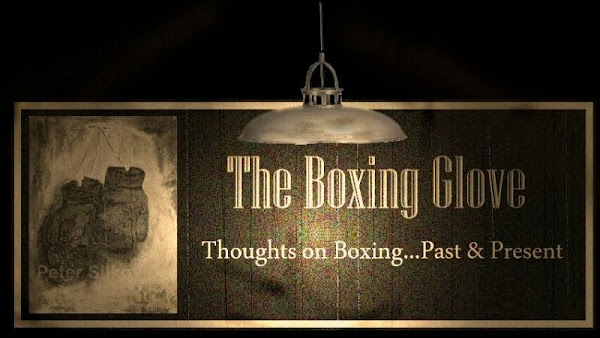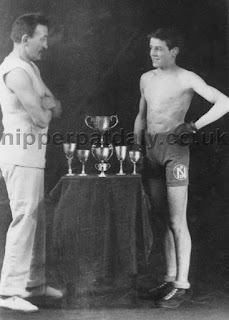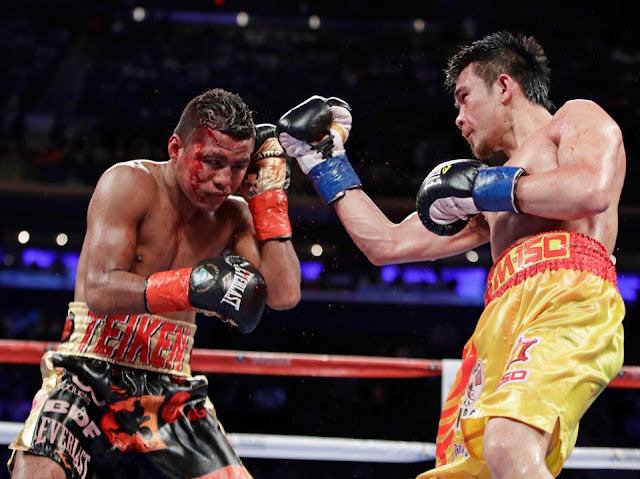By Peter Silkov
Now
that the pantomime is over between you know who, and what’s his
name, the smoke has finally cleared a little bit to reveal the most
eagerly anticipated middleweight fight since Hagler vs Hearns back in
1985. Gennady Golovkin (37-0, 33koes) and Saul Canelo Alvarez
(49-1-1, 34koes) meet next week, September 16, at the T-Mobile Arena,
Las Vegas, Nevada, in a clash that has been at least three years in
the making.
The
various controversies, whispers, and disagreements, which have
blocked this fight from happening, up until now, including Canelo’s
infamous ‘I am not a true middleweight yet!’ claim, are all well
known enough not to have to go into again. Now that the match is
finally here, what do we really have before us? Is it a real
‘superfight’ or something a little bit different, more along the
lines of a good business deal?
One
look at both men's records, and fighting styles, tells us that this
should be a well matched encounter that could produce something
special. Both men have primarily aggressive fighting styles, but are
also sound technically.
The
build up to this match has been respectful from both sides, which is
refreshing, and has added to the almost old school feel of this
showdown. This is the kind of showdown between top fighters that used
to happen regularly in boxing, but now is generally put off,
especially in the heavier divisions, save for the occasional
‘superfight.'
If
there is a worry, a person with a jaded eye might point out that the
pair have been almost too respectful in this build-up and that talk
of an upcoming ‘trilogy’ between the pair has been rather odd and
ill-timed.
It's
hard to think of any of boxing's famous ‘trilogies’ that have
been ‘pre-planned', and the very action of arranging a trilogy in
advance may lead won to wonder just how much planning has gone into
the actual fights themselves.
Yet,
one hopes that this slightly cynical fear will not be supported by
what is finally witnessed on September 16. Come fight night, we are
hoping to see both men giving 100% for victory, and for one of them
to be awarded with a fair victory free from controversy. This is what
boxing desperately needs, from a fight that it has been crying out
for over these past two years.
Trilogy
or not, this is a career defining fight for both men. For Canelo, it
is a chance for him to finally show that he is more than just a good
fighter who has been built up into something more by the media and
Golden Boy promotions. Gennady Golovin meanwhile, needs this victory
in order to finally underline the claims of greatness that have been
surrounding him.
 |
| Photo: Metro.Uk |
At
the age of 35 years old, GGG has dominated the 160-pound division
against anyone willing to get into the ring with him for the past 7
years, and over the course of 17 title defences. Despite this
impressive resume, Golovkin has yet to find that defining fight, that
defining defence, in which he has been called to show himself at his
very best under pressure. In much the same way as 80s middleweight
king, Marvin Hagler, struggled to find a meaningful fight before his
contests with Duran, Hearns, and Mugubi.
Against
Canelo, Golovkin will, for the first time, be facing an opponent whom
a large amount of people believe has a chance to beat him.
If
GGG beats Canelo, then his detractors will find it difficult to
seriously ask ‘who has Golovkin beaten?’ GGG has already beaten
the best at 160 pounds, aside from the three men that have
constantly avoided him; former WBC champion Miguel Cotto, WBO champ
Billy Joe Saunders, and up until now, Saul Canelo Alvarez. Indeed, it
is worth remembering that Canelo gave up the WBC championship, rather
than accept a fight with Golovkin earlier this year.
Looking
at both men’s careers, while it can be acknowledged that Canelo has
beaten the higher profile fighters compared to Golovkin, it must also
be said that Canelo has been moved along very cleverly, and faced far
more ‘soft targets’ than is often admitted. Since losing widely
to Floyd Mayweather Jr. 4 years ago, Canelo has faced the limited and
shop worn James Kirkland, Alfredo Angulo, and Julio Cesar Chavez Jr.,
the vastly out-weighed and over-matched, Amir Khan, and the largely
unproven at world level Liam Smith. Canelo’s best victories in the
past 4 years have come against the slippery Erislandy Lara, (a fight
in which many observers felt that Canelo was lucky to escape with a
victory) and against Miguel Cotto. Against Cotto, although Canelo
took victory and won the WBC world middleweight title in the process,
it was not a devastating performance by Canelo and again, there were
those who believed that the veteran Cotto had done enough to claim
victory.
 |
| Photo: RingTV |
The
common thead throughout Canelo’s
career is that he has never impressed quite as much as has been
expected of him. Even in his last fight last May, against Julio Cesar
Chavez Jr., in a fight so one-sided that it resembled a bad sparring
session. Canelo, for all his perceived strength and power, was unable
to floor Chavez Jr. even once, let alone stop him. Canelo looked
devastating against Amir Khan, yet even against the over-matched Liam
Smith, Canelo struggled at times to impress.
Canelo’s
strength has always been his size advantage over his opponents on
fight night. It is well known that he goes up to 180 pounds at least,
by fight night. Technically he is a sound fighter with a good chin,
but he is also one-paced, and lacks flexibility in the ring.
Mayweather, Lara and even Khan, showed how Canelo can be out-boxed,
and dominated by the jab. Is this a strategy, which Golovkin might
try against Alvarez?
Golovkin
is usually thought of as an all-action slugger with a knockout punch
in either hand, yet he has shown in the past that he is also a very
shrewd technical boxer when he wants. Against David Lemieux in 2015,
instead of going toe-to-toe with the big-punching Canadian, GGG chose
to clinically take him apart with a technical display that GGG has
not shown since.
Against
such a physically strong fighter as Alvarez, who looks to have a
sound chin, Golovkin may well need to call upon his finer boxing
skills, just as he did when he took on Lemieux.
The
worry for GGG’s supporters might be that at 35, the Kazakhstan
fighting machine is beginning to feel the wear and tear of 18 world
title fights, and father time. Certainly GGG’s last outing, six
months ago against Daniel Jacobs, which saw the champion taken the
full 12 rounds for the first time in his career, was his most
unimpressive performance since he first won his world titles. There
were those who felt that he was lucky to leave the ring still with
his titles.
 |
| Photo: Boxing News |
Golovkin
has since said himself that it is the Jacobs fight that helped
finally make his match with Canelo. Was it just an off night for GGG
or was it a clear indication of a decay in his pugilistic skills. It
should also be remembered that in his previous fight against
England’s Kell Brook, Golovkin looked slow and sloppy at times with
an almost non-existent defence, before finally stopping Brook in the
5th
round.
Are
these performances indications of decline, or simply a symptom of
GGG’s growing boredom at being unable to gain the big fights that
he has wanted for so long.
In
fact, it might also be argued that perhaps GGG has purposely ‘held
back’ in recent defences, in an effort to make himself look more
match friendly to Canelo Alvarez.
It
is clear that GGG has not been the precise fighting machine he was
against Lemieux, for at least his last two fights.
Here
lies the crucial part of this upcoming contest. If Golovkin can find
the form that he showed 2 or 3 years ago, then he should have a clear
technical edge over Canelo. At his best, Golovkin is a much more
versatile boxer than Canelo.
 |
| Photo: Fightland.com |
Canelo’s
main attributes are his physical strength, and his comparative youth
compared to GGG. At 27, Canelo Alvarez is at his physical peak while
Golovkin at 35, as discussed earlier, is most likely past his peak.
This
all goes together to make their fight that much closer. While
Golovkin might have been a clear favourite 2 years ago, now he is
not.
This
match up could play out in two distinct ways. On the one hand, we
could see both going toe-to-toe in an all out brawl, to test each
other's durability and resolve, alternatively, we could see a much
more technical fight, even perhaps a bit of a chess match between the
two men. GGG will look to use his jab and wear down Canelo over the
distance. If Alvarez has shown a weakness, other than his
one-dimensional fighting style, it is his tendency to tire in the
later rounds of fights. However in order to tire Canelo, GGG will
have to work at a high pace himself, higher than he did against
Jacobs in his last fight.
Can
Golovkin operate at a high pace himself over 12 rounds, a distance,
which Canelo is used to travelling in comparison.
Barring
any scoring controversies, this fight is likely to be won by the
fighter who can set the higher pace. Yet, Golovkin's best chance of
victory may well come inside the distance. If the fight goes the
full 12 rounds, (and is a competitive affair, as it is most likely to
be) then it is hard not to envisage the Las Vegas Judges favouring
Golden Boy’s favourite son. We have seen Canelo gain decisions
over Lara and Trout, which were questionable and who can forget the
judge who made his fight with Mayweather Jr. a draw!
Despite
his popularity with the fans, Golovkin will most definitely be the
‘outsider’ in this fight, and one needs only to look at the
recent two Andre Ward vs Sergey Kovalev contests to see what can
happen when you are fighting a favoured fighter in Las Vegas.
Golovkin will have to go into this fight with the mindset that he
will need either a stoppage or a completely dominant performance over
the distance in order to claim victory.
The
feeling at The Boxing Glove is that Golovkin either wins this match
inside the distance after wearing Alvarez down, or else he is looking
at losing perhaps controversially on points. One doesn’t like to
be a cynic, but after watching recent big fights, especially in
Vegas, it is hard not to be. Vegas has a habit of siding with the
house fighter.
Let’s
hope that I am wrong and that we see a great fight, followed by a
just result free from controversy. That would really make Saturday's
fight something special.
If you are an athlete and want us to follow you or tell your story, contact petersilkov@yahoo.com or theboxingglove@yahoo.com




































